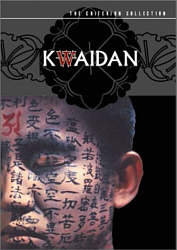 Yesterday evening and this morning I watched Kwaidan. I picked up a copy of the DVD at the Indianapolis Library knowing nothing about it. I figured if it was a Criterion Collection movie that it couldn't be all that bad. The description on the back flap of the DVD case tells you this is "four nightmarish tales in which terror thrives." In my opinion that is misleading.
Yesterday evening and this morning I watched Kwaidan. I picked up a copy of the DVD at the Indianapolis Library knowing nothing about it. I figured if it was a Criterion Collection movie that it couldn't be all that bad. The description on the back flap of the DVD case tells you this is "four nightmarish tales in which terror thrives." In my opinion that is misleading.The film is broken up into four stories, "The Black Hair," "The Woman of the Snow," "Hoichi, The Earless," and "A Cup of Tea." As far as I can tell after one viewing, the stories do not tie together in any other sense except they are packaged together in this one film. They definately could be watched seperately.
I didn't see any of the tales as horror stories in the conventional sense. "The Black Hair" seemed more like a morality tale. My roomate even compared it to Poe. "The Woman of the Snow" was probably my favorite one, though I can't really say why without giving away the story. "Hoichi, The Earless" was stunning. There were recreations of battle scenes throughout and the prescence of teh supernatural in that story, especially as Hoichi retells the story of the battles to a court is probably the films best visual moment. "A Cup of Tea" was short, effective, open ended and a great way to end the film. It was probably the most entertaining of the four stories.
It's hard to believe when you are watching this that these stories were actually, origibaly Western in orgin. The films stories are based on the stories of Lafcadio Hearn, a folklorist of Greek/Irish ancestry who moved to the United States and eventually Japan. The stories seem so outside of traditional Western storytelling. "The Black Hair," which I earlier mentioned my friend compared to Poe was definately the most western feeling of the stories. The way the other three tackle the supernatural is definately more outside the boundries of Western storytelling.
It would be crimial to mention the stories to without mentioning the soundtrack and color. I would venture a guess that there was dialogue less than 50% of the film. Instead of actuall dialogue the filmaker used a magnificent soundtrack to create tension more often than not. And from the opening credits, when you see splashes of red, black, and blue ink the use of color througout is phenomenal. It's odd, as this was a 1965 film that the colors seemed so much more vivid than films today but that was the case.
I am guessing this is a film that you'd actually have to seek out to find. I never saw it in Blockbuster or at any other rental places. As I said, I just lucked into it at my library. But I am definately glad I did. The film is low moving, and not very traditional horror stories, but if you are in the mood for something different, I would definately suggest this.
No comments:
Post a Comment